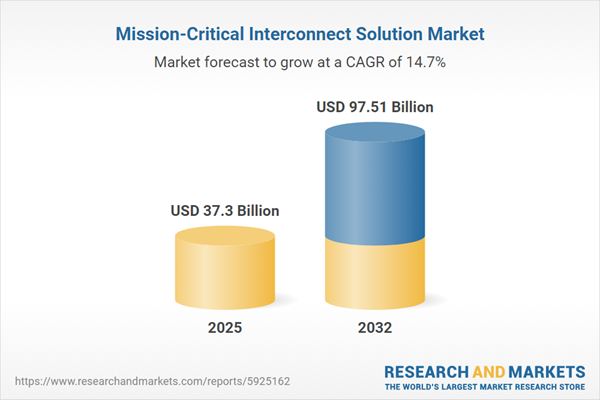Speak directly to the analyst to clarify any post sales queries you may have.
The mission-critical interconnect solution market is rapidly transforming network infrastructure for enterprises, data centers, and industrial operations. Amid rising connectivity demands and evolving technical benchmarks, senior leaders must anticipate continued innovation, regulatory complexity, and shifting supply chain dynamics to drive resilient growth.
Market Snapshot: Mission-Critical Interconnect Solution Market
The Mission-Critical Interconnect Solution Market grew from USD 32.50 billion in 2024 to USD 37.30 billion in 2025. It is expected to continue growing at a CAGR of 14.72%, reaching USD 97.51 billion by 2032. This growth reflects rising investments by enterprise, data center, telecom, and industrial stakeholders in reliable, high-speed connectivity, as well as increased demand for advanced interconnect technologies worldwide. Market expansion is influenced by new applications, emerging use cases, and persistent pressure for lower latency, enhanced signal integrity, and operational continuity.
Scope & Segmentation of the Mission-Critical Interconnect Solution Market
- Applications: Data center deployments, enterprise campus environments, industrial automation, and telecom service provider networks.
- Technologies: Copper cabling, hybrid assemblies, optical fiber (including multi-mode and single-mode implementations).
- Component Types: Cables, a wide range of connectors (such as LC, MPO, RJ45, and SC variants), and multiple transceiver modules.
- Data Rates: Solutions addressing applications from 10G to 100G and above for various throughput requirements.
- Geographies: Americas (North and Latin America), Europe, Middle East & Africa, and Asia-Pacific—with coverage of developed and emerging network infrastructure regions.
- Companies Analyzed: TE Connectivity Ltd., Amphenol Corporation, 3M Company, Belden Inc., ITT Inc., Huber+Suhner AG, Eaton Corporation plc, Phoenix Contact GmbH & Co. KG, Rosenberger Hochfrequenztechnik GmbH & Co. KG, LAPP Holding AG.
Key Takeaways for Senior Decision-Makers
- The mission-critical interconnect solution market is shaped by technology upgrades, with a clear shift towards hybrid and high-density optical solutions to address bandwidth and reliability demands.
- A surge in smart manufacturing and industrial automation is increasing requirements for rugged connectors and robust cable assemblies that withstand harsh conditions.
- Cloud and hyperscale data center operators are accelerating the deployment of programmable photonics, enabling greater flexibility and rapid scaling within evolving network architectures.
- Global suppliers are adapting to regional policy changes by diversifying manufacturing footprints and investing in innovative materials to improve efficiency and mitigate supply risks.
- Vendors are introducing value-added services—such as predictive maintenance and digital health monitoring—to help enterprises optimize asset life cycles and performance planning.
Tariff Impact on Supply Chains and Costs
Newly implemented U.S. tariffs on interconnect components are reshaping global cost structures and prompting a strategic realignment of supply chains. Manufacturers and suppliers are pursuing alternative sourcing, including nearshoring and vertical integration, to counter margin pressures and ensure delivery continuity across regions. This environment is catalyzing advances in production methods, with a focus on material innovation and efficiency gains as companies navigate evolving trade frameworks.
Methodology & Data Sources
This analysis leverages primary interviews with senior executives, in-depth reviews of technical publications, and robust quantitative techniques. Data from component shipments, policy documents, and industry research are triangulated with expert insights to ensure accuracy, depth, and practical relevance.
Why This Report Matters for Decision-Makers
- Enables effective roadmapping for network upgrades, supplier evaluation, and procurement strategy tailored to resilience and future growth needs.
- Equips stakeholders with region-specific insights on infrastructure development, technology adoption, and sourcing risks.
- Supports negotiations by clearly outlining how regulatory and tariff shifts can directly influence costs and competitive positioning.
Conclusion
The mission-critical interconnect solution market is defined by continual advancements in technology, regulatory changes, and evolving supply chain priorities. Decision-makers leveraging the insights captured here will be positioned to drive reliable, scalable, and sustainable network transformation initiatives.
Additional Product Information:
- Purchase of this report includes 1 year online access with quarterly updates.
- This report can be updated on request. Please contact our Customer Experience team using the Ask a Question widget on our website.
Table of Contents
3. Executive Summary
4. Market Overview
7. Cumulative Impact of Artificial Intelligence 2025
Companies Mentioned
The companies profiled in this Mission-Critical Interconnect Solution market report include:- TE Connectivity Ltd.
- Amphenol Corporation
- 3M Company
- Belden Inc.
- ITT Inc.
- Huber+Suhner AG
- Eaton Corporation plc
- Phoenix Contact GmbH & Co. KG
- Rosenberger Hochfrequenztechnik GmbH & Co. KG
- LAPP Holding AG
Table Information
| Report Attribute | Details |
|---|---|
| No. of Pages | 197 |
| Published | October 2025 |
| Forecast Period | 2025 - 2032 |
| Estimated Market Value ( USD | $ 37.3 Billion |
| Forecasted Market Value ( USD | $ 97.51 Billion |
| Compound Annual Growth Rate | 14.7% |
| Regions Covered | Global |
| No. of Companies Mentioned | 11 |









